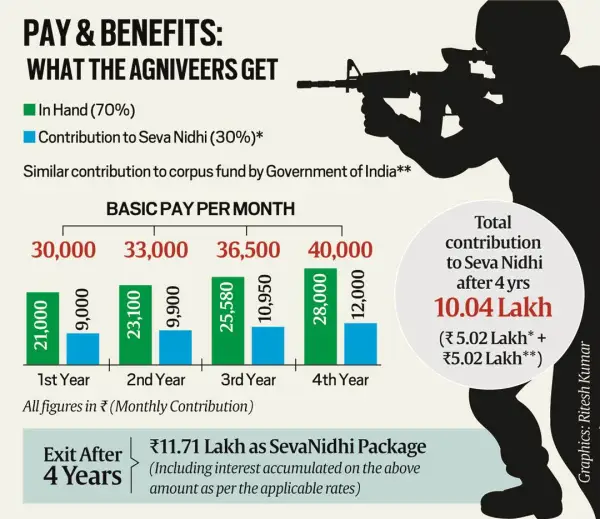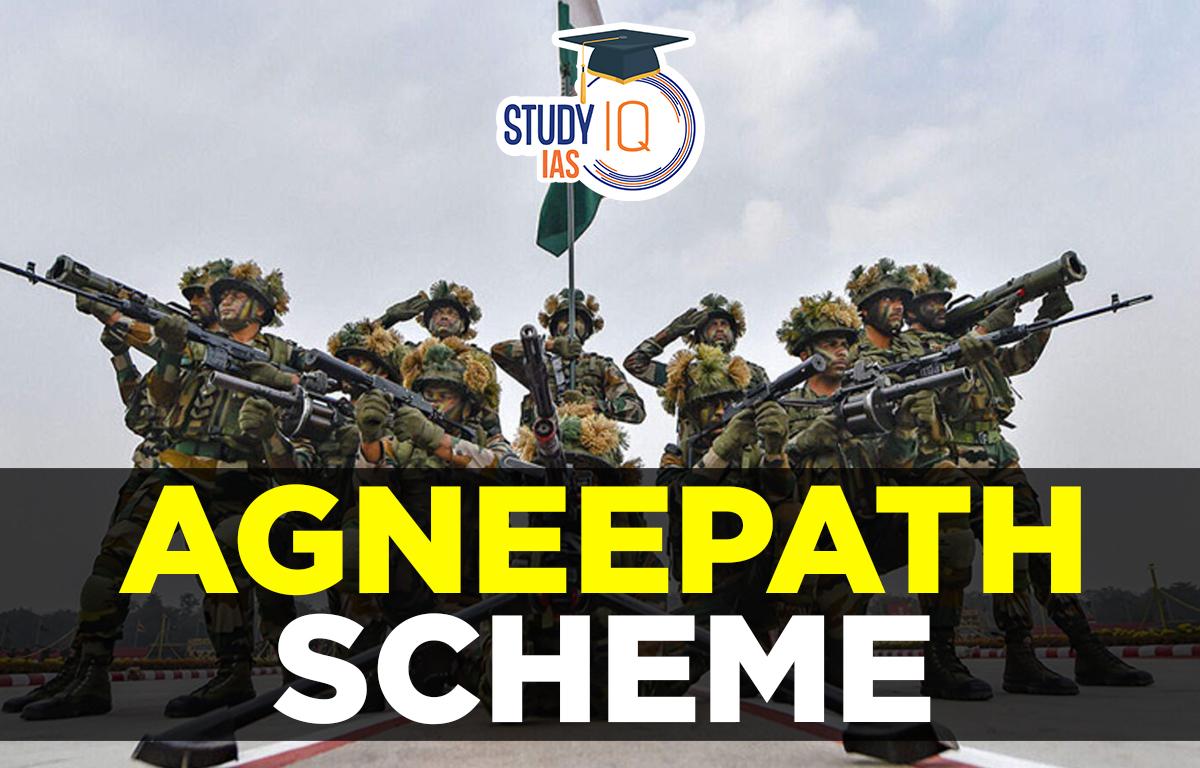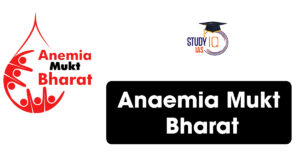Table of Contents
Context: The Indian Army has recently undertaken an internal survey to evaluate the Agnipath Scheme as this scheme completed its two years.
- The Agnipath military recruitment scheme, introduced in June 2022, faced opposition from the INDIA bloc and Armed Forces veterans.
- Following the BJP’s underperformance in key states, allies like JD(U) and LJP have urged a review of the scheme.
Agnipath Scheme
| About Agneepath Scheme | |
| Launch Date | Agnipath Scheme was introduced on June 14, 2022. |
| Purpose |
|
| Eligibility Criteria |
|
| Women Recruitment | Facilitated women’s recruitment as Agniveers in IAF and Navy, with the Army beginning women’s recruitment in its Corps of Military Police in 2019. |
Who is Agniveer?
Agniveers will be the name given to the young people selected for the Agneepath initiative. After four years, agniveers will be given the chance to apply for permanent enlistment in the armed forces.
Young people between the ages of 17.5 and 21 (revised upper age limit) who value patriotism, teamwork, improving physical fitness, ingrained loyalty to the nation, and the availability of trained personnel to strengthen national security in times of external threats, internal threats, and natural disasters are encouraged to apply through the Agneepath Yojna to become Agniveers.
The candidates for this recruitment procedure are known as “Agniveers.” After four years of employment, “Agniveers” will get competitive pay and an exit retirement package, according to the decision. It is important to note that this change is only available to employees who are below the level of officer, or to those who do not join the military as commissioned officers.
Objectives of Agnipath Scheme
- Youthful Profile: Aims to rejuvenate the armed forces’ demographic by lowering the average age of serving personnel.
- Modernization: Intends to morph the forces into a tech-savvy modern entity.
- Post-Retirement Skill Utilisation: Envisions skilled, disciplined youth contributing to civil society post-retirement.
- Defence Pension Bill Reduction: A significant motive is to curtail the rising defence pension expenses for the Indian government.
Recruitment Under Agnipath
- Army: Two batches of 40,000 Agniveers have completed training, with a third batch of 20,000 starting in November 2023.
- Navy: Three batches totalling 7,385 Agniveers have completed their training.
- Air Force: A total of 4,955 Agniveers have finished their training in the IAF.
Benefits of Agnipath Scheme: Compensation Structure
Salary of Agniveers
- Remuneration: Monthly pay ranges from Rs 30,000 to Rs 40,000, with additional risk and hardship allowances.
- Seva Nidhi Package: A contributory scheme where Agniveers and the government each contribute 30% of the monthly emoluments, culminating in around Rs 11.71 lakh (with interest) post four years, tax-exempt.
- Death/Disability Compensation: In case of on-duty death, over Rs 1 crore is awarded; disability compensation up to Rs 44 lakh, based on disability extent related to military service.

Comparison with Regular Soldiers
- Pension: Regular soldiers receive a pension, whereas Agniveers don’t, except the 25% who transition to regular service post-contract.
- Battle Casualty Compensation: Regular soldiers’ families receive a liberalised lifetime pension; Agniveers’ families receive a non-contributory insurance sum of Rs 48 lakh.
- Gratuity and Insurance: Regular soldiers get a 15-day gratuity per service year and Rs 50 lakh insurance cover, perks not available to Agniveers.
- Salary: Regular soldiers start at around Rs 40,000, inclusive of military service pay and dearness allowance, compared to Agniveers’ Rs 30,000.
- Disability Compensation: Regular soldiers receive a pension, ex gratia, and impairment relief, while Agniveers receive an ex gratia amount, remaining pay for the four-year tenure, and Seva Nidhi scheme benefits.
Qualification for Agneepath Scheme
| Post | Qualification | Age |
| Soldier General Duty | SSLC/Matric with a cumulative grade point average of 45%. Higher education is not required. | 17.5 – 21 Years |
| Soldier Technical | Passed Physics, Chemistry, Math, and English portions of the 10+2/Intermediate exam in Science. Eight is the new age for higher education. | 17.5 – 21 Years |
| SoldierClerk / Storekeeper Technical | 10+2/Intermediate exam passed in any field (Arts, Commerce, Science) with a minimum of 40% in each subject and 50% overall. Age considerations in higher qualification | 17.5 – 21 Years |
| Soldier Nursing Assistant | Passed the 10+2/Intermediate science test with Physics, Chemistry, Biology, and English with a minimum of 50% overall and a minimum of 40% in each subject. Eight is the new age for higher education | 17.5 – 21 Years |
| Soldier Tradesman | 17.5 – 21 Years | |
| (i)GeneralDuties | Non-Matric | 17.5 – 21 Years |
| (ii)SpecifiedDuties | Non-Matric | 17.5 – 21 Years |
Key Differences with Regular Military Service under Agnipath Scheme
- No Pension: Agniveers do not receive a pension after retirement, unlike regular military personnel.
- Service Absorption: Only 25% of Agniveers who continue in the forces after four years are eligible for pension benefits, and their initial four-year tenure does not count towards these benefits.
- Impact on Force Levels and Costs: The Agnipath scheme aims to lower permanent force levels and reduce the defence pension bill, addressing long-standing financial concerns within the government.
Reasons for Introducing Agnipath Scheme
- Reduction of Costs: The primary but unofficial reason for the introduction of Agnipath is to reduce the Armed Forces’ wage and pension expenses.
- Maintaining a Youthful Force: The scheme aims to ensure a younger average age within the Armed Forces, lowering it from 32 to 26 years, thereby keeping the force youthful, high-tech, and ultra-modern.
- Post-Service Contributions: The government contends that Agniveers will enhance civil society with their education, skills, discipline, and other qualities after their service, boosting workforce skills and contributing to GDP growth.
- Rehabilitation Support: The government plans to assist soldiers exiting after four years with skill certificates and bridge courses to facilitate their transition.
Opposition to Agnipath
- Perceived Inequality: Critics argue that Agnipath creates a secondary class of soldiers with fewer benefits, pay, and prospects despite performing similar duties as regular soldiers.
- Economic and Social Concerns: The scheme is seen as limiting the traditional path to economic stability and upward mobility offered by military service, leading to widespread dissatisfaction.
- Political Parties Stance: Multiple political parties have advocated for scrapping the scheme due to its perceived injustices and disparities.
Government’s Stance on Modifying Agnipath
- Recent reports suggest the government is open to modifying the scheme to better meet the needs of the Armed Forces while maintaining a youthful profile.
- The Armed Forces are conducting internal assessments to recommend possible changes.
Agnipath Scheme UPSC
The Agnipath Scheme is a topic of news coverage and is significant in terms of current affairs. The questions on the UPSC Syllabus frequently reflect current events. Both for the UPSC Prelims and UPSC Mains, the Agnipath Scheme is crucial. It is covered in the section GS Paper 3: Various Security Forces and Agencies and Their Mandates of the UPSC Mains Syllabus.
| Other Important Articles | |
| Swadesh Darshan Scheme | Production Linked Incentive (PLI) Scheme |
| Electoral Bonds Scheme | Beti Bachao Beti Padhao Scheme |


 Anaemia Mukt Bharat: India’s Fight Aga...
Anaemia Mukt Bharat: India’s Fight Aga...
 Digital Bharat Nidhi Boost to Rural Tele...
Digital Bharat Nidhi Boost to Rural Tele...
 Jal Jeevan Mission, Objectives, Benefits...
Jal Jeevan Mission, Objectives, Benefits...





















